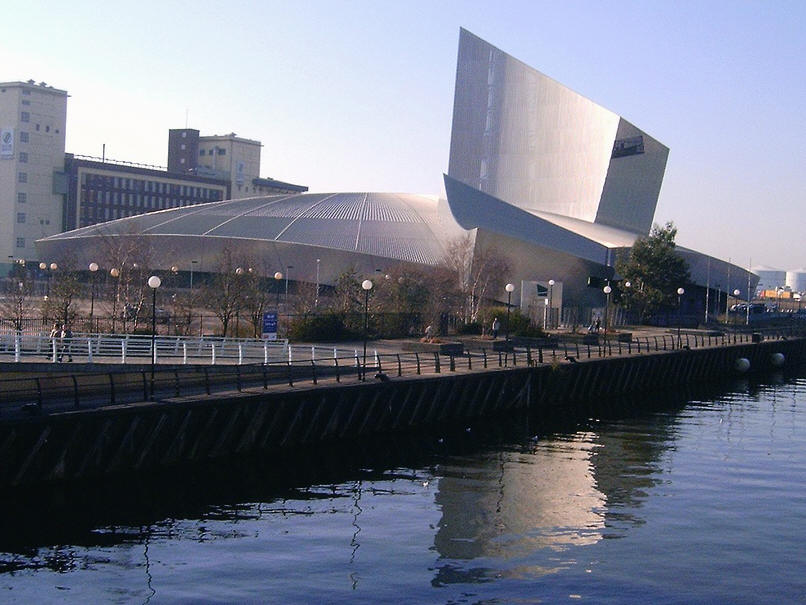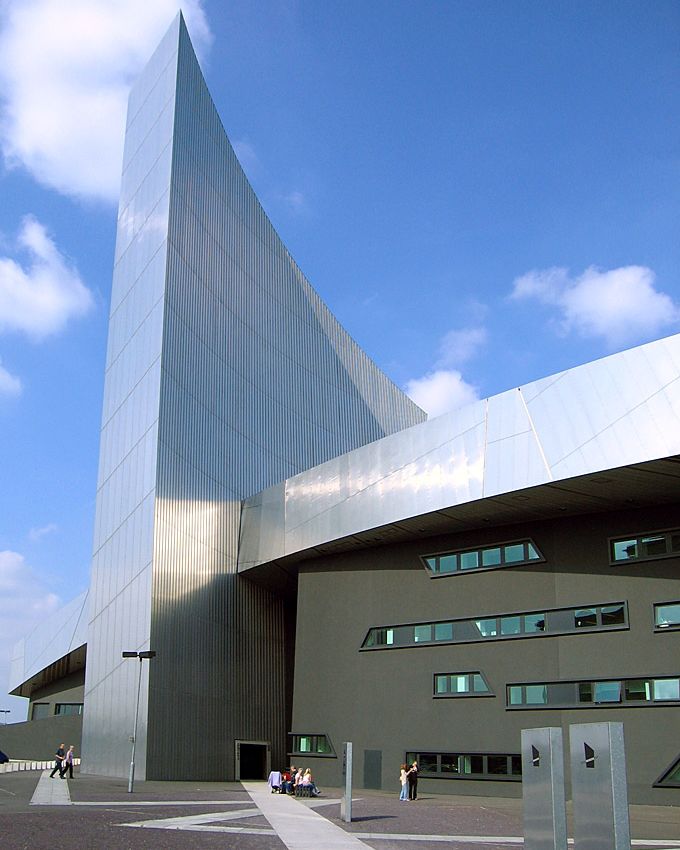The Imperial War Museum North (sometimes referred to as IWM North) is a museum in the Metropolitan Borough of Trafford in Greater Manchester, England. One of five branches of the Imperial War Museum, it explores the impact of modern conflicts on people and society. It is the first branch of the Imperial War Museum to be located in the north of England. The museum occupies a site overlooking the Manchester Ship Canal in Trafford Park, an area which during the Second World War was a key industrial centre and consequently heavily bombed during the Manchester BlitzHeavy bombing of the city of Manchester and its surrounding areas in North West England during the Second World War by the Nazi German Luftwaffe.Heavy bombing of the city of Manchester and its surrounding areas in North West England during the Second World War by the Nazi German Luftwaffe. in 1940. The area is now home to the Lowry cultural centre and the MediaCityUK development, which stand opposite the museum at Salford Quays.
The museum building was designed by the architect Daniel Libeskind and opened in July 2002, receiving 470,000 visitors in its first year of opening. It was recognised with awards or prize nominations for its architecture and is a prime example of Deconstructivist architecture. The museum features a permanent exhibition of chronological and thematic displays, supported by hourly audiovisual presentations which are projected throughout the gallery space. The museum also hosts a programme of temporary exhibitions in a separate gallery. Since opening, the museum has operated a successful volunteer programme, which since January 2007 has been run in partnership with Manchester Museum. As part of a national museum, Imperial War Museum North is financed by the Department for Culture, Media and Sport and by self-generated income. Admission is free.
Planning and construction

Wikimedia Commons
During the 1990s, the Imperial War Museum sought to open a branch in the north of England. Seventy-one sites were offered for consideration by 36 local councils.[1] One such council was that of Hartlepool, in County Durham, for whom a new museum building was designed by architect Sir Norman Foster for a site on Hartlepool’s dockside.[2] In 1992 the Teesside Development Corporation offered the museum, on behalf of Hartlepool council, a total of £14.4 million towards construction and running costs.[3] However, the National Audit Office later reported that the corporation’s offer breached government rules and negotiations were abandoned.[3][4]
It was decided eventually to contruct the new museum in Trafford, Greater Manchester. The Trafford ParkFirst planned industrial estate in the world, and still the largest in Europe. area has strong associations with the Second World War on the British home front; factories in the area produced Avro Lancaster heavy bombers and Rolls-Royce Merlin aero engines used by a number of Royal Air Force combat aircraft.[5] The area was consequently heavily bombed, particularly during the Manchester BlitzHeavy bombing of the city of Manchester and its surrounding areas in North West England during the Second World War by the Nazi German Luftwaffe.Heavy bombing of the city of Manchester and its surrounding areas in North West England during the Second World War by the Nazi German Luftwaffe., when 684 people were killed in raids over two nights in December 1940.[6] Planning permission to build the museum on a site where the Hovis Grain Silos once stood before, being destroyed by bombing,[7] was granted in April 1999.[8]
Architecture
An architectural competition for the new museum was held in 1997, the winner of which was a design by Berlin-based architect Daniel Libeskind. Born in Łódź, Poland, in 1946, Libeskind’s family had suffered during the Second World War and dozens of his relatives were murdered in the Holocaust. At the museum’s opening, Libeskind said that he sought to “create a building … which emotionally moved the soul of the visitor toward a sometimes unexpected realization”‘.[9] Libeskind envisaged “a globe shattered into fragments and then reassembled”. The building represents an interlocking of three of these fragments, earth, air and water, each forming a functionally distinct part of the museum.[10] The 55 metres (180 ft) high air shard, provides the museum’s entranceway and a viewing balcony (now closed to the public) above the Manchester Ship Canal with views of the Manchester skyline. The construction of the tower leaves viewers exposed to the elements and one reviewer considered that it reflected “the aerial perspective of modern warfare and the precariousness of the life below”.[1] The earth shard houses the museum’s exhibition spaces, and the water shard accommodates a cafe with views of the canal.[10]
Originally budgeted at £40 million, the museum was eventually completed for £28.5 million after anticipated National Lottery funding was not forthcoming. The museum was funded by local, national and European development agencies. The European Union’s European Regional Development Fund contributed £8.9 million, English Partnerships and the North West Development Agency £2.7 million, and £2.8 million was provided by Trafford Metropolitan Borough Council. Peel Holdings, a local transport and property company, contributed £12.5 million;[8] this was reportedly the largest single sum ever given to a UK cultural project by a private enterprise.[11] The reduction in budget forced a number of changes; the substitution of metal for concrete in the construction of the shards, the removal of a planned auditorium, and a change of exhibition content. The site’s external landscaping also had to be reduced; in 2009, following an architectural design competition managed by RIBA Competitions, Berlin-based company Topotek 1 were appointed to complete this landscaping.[12] Despite these economies, the fundamental “shattered globe” concept remained intact.[13] A final £3 million was raised by a fundraising campaign led by BBC News war correspondent Kate Adie.[14] Construction of the museum, by structural engineers Arup and main contractor Sir Robert McAlpine, began on 5 January 2000[10] and the building was topped out in late September that year.[13] The museum was officially opened by Prince Philip on 24 July 2002, shortly before Manchester hosted the 2002 Commonwealth Games.[15]
Exhibitions
Permanent exhibitions are housed in the museum’s first-floor main gallery space within the earth shard. These consist of a chronological display which runs around the gallery’s 200-metre (660 ft) perimeter and six thematic displays in “silos” within the space. As part of the earth shard, the 3500 square metres (4,186 yd2) floor of the gallery is curved, gradually dropping away like the curvature of the Earth from a nominal “North Pole” near the gallery’s entrance.[16] Within this hall, which has been described as cavernous and dramatic,[14][17] a number of large artefacts are displayed; they include a Russian T-34 tank, a United States Marine Corps AV-8B Harrier jet and a 13-pounder field gun which fired the British Army’s first shot of the First World War.[18] Around the gallery, a number of vertical mechanical conveyors called “timestacks” display selections of smaller artefacts, some of which can be handled by visitors.[14][19][20]
In addition to the physical exhibits, the walls of the gallery space are used as screens for the projection of hourly audiovisual presentations called the Big Picture, which explore themes related to modern conflict. These presentations use up to 1500 images from the Imperial War Museum’s photograph archive and were originally projected from 60 synchronised slide projectors mounted throughout the space.[19] In 2011 digital projectors were installed, allowing a greater degree of flexibility.[21] The images are complemented by personal accounts from the museum’s oral history sound archive. The Big Picture was devised after the reduction in the museum’s budget forced the scrapping of the previous exhibition plan by designers DEGW and Amalgam.[22]
Also within the earth shard, a separate gallery accommodates a programme of temporary exhibitions. These have included the Witness series of art exhibitions from the museum’s collection, examining First and Second World War art, and the work of female war artists.[23][24][25]
Reception
The museum enjoyed a successful first year, with an initial target of 300,000 visitors surpassed after six months,[26] with over 100,000 visitors in the first six weeks;[27] by the museum’s first anniversary on 5 July 2003 some 470,000 visitors had been received.[28] The museum received a largely positive reception, reviewers remarking on the metaphorical power of the building, the complementary effects of the museum’s main exhibition with its internal architecture, and the economy with which the museum was built.[1][18] In August 2005 the Imperial War Museum North received its millionth visitor.[29] The museum was, however, criticised by The Guardian in 2008 for poor energy efficiency, as part of a report into the carbon dioxide emissions of UK public buildings.[30]



